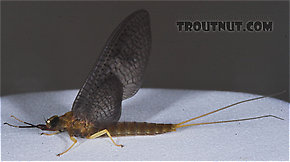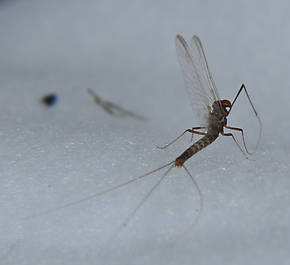Blog & Latest Updates
Fly Fishing Articles
Insects by Common Name


Mahogany Duns
Scientific Names
Like most common names, "Mahogany Dun" can refer to more than one taxon. They're previewed below, along with 11 specimens. For more detail click through to the scientific names.
Mayfly Species Isonychia bicolor
These are pretty much always called Mahogany Duns.
This is by far the most important species of Isonychia. Many angling books once split its credit with the species Isonychia sadleri and Isonychia harperi, but entomologists have since discovered that those are just variations of this abundant species.
See the main Isonychia page for more about these intriguing mayflies.
See the main Isonychia page for more about these intriguing mayflies.
Isonychia bicolor (Mahogany Dun) Mayfly Nymph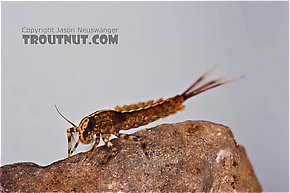 View 7 PicturesThis Isonychia bicolor nymph from the Catskills displays the prominent white stripe sometimes characteristic of its species. This is the first such specimen I've photographed, because members of the same species in the Upper Midwest have a more subdued stripe (and were once thought to be a different species, Isonychia sadleri). The striking coloration on this eastern nymph is more appealing.
View 7 PicturesThis Isonychia bicolor nymph from the Catskills displays the prominent white stripe sometimes characteristic of its species. This is the first such specimen I've photographed, because members of the same species in the Upper Midwest have a more subdued stripe (and were once thought to be a different species, Isonychia sadleri). The striking coloration on this eastern nymph is more appealing.
 View 7 PicturesThis Isonychia bicolor nymph from the Catskills displays the prominent white stripe sometimes characteristic of its species. This is the first such specimen I've photographed, because members of the same species in the Upper Midwest have a more subdued stripe (and were once thought to be a different species, Isonychia sadleri). The striking coloration on this eastern nymph is more appealing.
View 7 PicturesThis Isonychia bicolor nymph from the Catskills displays the prominent white stripe sometimes characteristic of its species. This is the first such specimen I've photographed, because members of the same species in the Upper Midwest have a more subdued stripe (and were once thought to be a different species, Isonychia sadleri). The striking coloration on this eastern nymph is more appealing.Male Isonychia bicolor (Mahogany Dun) Mayfly Spinner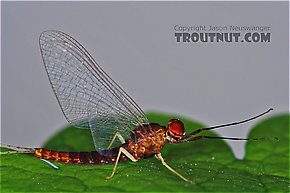 View 15 PicturesI got several really nice pictures of this spinner. I also collected a female on the same trip.
View 15 PicturesI got several really nice pictures of this spinner. I also collected a female on the same trip.
 View 15 PicturesI got several really nice pictures of this spinner. I also collected a female on the same trip.
View 15 PicturesI got several really nice pictures of this spinner. I also collected a female on the same trip.See 16 more specimens...
Mayfly Species Paraleptophlebia bicornuta
These are pretty much always called Mahogany Duns.
This important Western species is one of the few mayflies outside the Ephemeridae family to possess large tusks on the front of its head. It is also one of the largest species of Paraleptophlebia.
P. bicornuta is often reinforced by simultaneous hatches of the more common Paraleptophlebia debilis. The two duns appear virtually identical to the naked eye, though bicornuta usually has an edge in size.
Paraleptophlebia bicornuta is by far the widest distributed tusked species, though there are others. Telling the tusked species apart is very difficult and even entomological texts are largely ambiguous on the characters that differentiate them. Distribution records are probably the most reliable way for anglers to know with any probability what they are looking at. Check out the Paraleptophlebia packii and Paraleptophlebia helena hatch pages for more distribution information.
P. bicornuta is often reinforced by simultaneous hatches of the more common Paraleptophlebia debilis. The two duns appear virtually identical to the naked eye, though bicornuta usually has an edge in size.
Paraleptophlebia bicornuta is by far the widest distributed tusked species, though there are others. Telling the tusked species apart is very difficult and even entomological texts are largely ambiguous on the characters that differentiate them. Distribution records are probably the most reliable way for anglers to know with any probability what they are looking at. Check out the Paraleptophlebia packii and Paraleptophlebia helena hatch pages for more distribution information.
Paraleptophlebia bicornuta (Mahogany Dun) Mayfly Nymph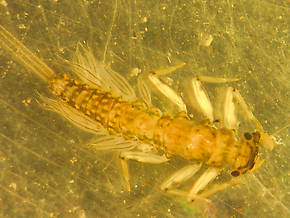 View 1 PicturesThis species is interesting because it is common in lakes as well as streams. It is one of the last species of the year to emerge in western Montana. Adults have been collected as late as October 15 weather permitting.
View 1 PicturesThis species is interesting because it is common in lakes as well as streams. It is one of the last species of the year to emerge in western Montana. Adults have been collected as late as October 15 weather permitting.
 View 1 PicturesThis species is interesting because it is common in lakes as well as streams. It is one of the last species of the year to emerge in western Montana. Adults have been collected as late as October 15 weather permitting.
View 1 PicturesThis species is interesting because it is common in lakes as well as streams. It is one of the last species of the year to emerge in western Montana. Adults have been collected as late as October 15 weather permitting.Male Paraleptophlebia bicornuta (Mahogany Dun) Mayfly Dun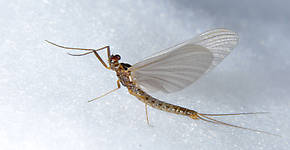 View 1 PicturesYou wonder sometimes how certain insects get their common names. This one is called the 'mahogany dun' for some unknown reason.
View 1 PicturesYou wonder sometimes how certain insects get their common names. This one is called the 'mahogany dun' for some unknown reason.
 View 1 PicturesYou wonder sometimes how certain insects get their common names. This one is called the 'mahogany dun' for some unknown reason.
View 1 PicturesYou wonder sometimes how certain insects get their common names. This one is called the 'mahogany dun' for some unknown reason.See 2 more specimens...
Mayfly Species Paraleptophlebia debilis
These are pretty much always called Mahogany Duns.
This widespread species can produce memorable hatches where it is locally abundant, especially in the West where it also tends to run larger in size. It loves the margins as is typical of most Leptophlebiidae species but has a greater tolerance for current. They are often found even in riffles. This is the most important species in the West.
Female Paraleptophlebia debilis (Mahogany Dun) Mayfly Dun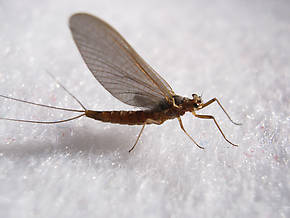 View 3 PicturesSize: 9mm. These photos really highlight the brown pigmentation of the wing venation (Venation: The pattern in which the veins on the wings of an insect are arranged. It is usually one of the most useful identifying characteristics.), but in the hand the wings look to be a uniform smokey gray. - Entoman
View 3 PicturesSize: 9mm. These photos really highlight the brown pigmentation of the wing venation (Venation: The pattern in which the veins on the wings of an insect are arranged. It is usually one of the most useful identifying characteristics.), but in the hand the wings look to be a uniform smokey gray. - Entoman
 View 3 PicturesSize: 9mm. These photos really highlight the brown pigmentation of the wing venation (Venation: The pattern in which the veins on the wings of an insect are arranged. It is usually one of the most useful identifying characteristics.), but in the hand the wings look to be a uniform smokey gray. - Entoman
View 3 PicturesSize: 9mm. These photos really highlight the brown pigmentation of the wing venation (Venation: The pattern in which the veins on the wings of an insect are arranged. It is usually one of the most useful identifying characteristics.), but in the hand the wings look to be a uniform smokey gray. - EntomanMayfly Species Paraleptophlebia helena
These are pretty much always called Mahogany Duns.
This large species of Paraleptophlebia is one of the tusked group. Records indicate it is endemic (Endemic: where found; native to; belonging exclusively to or confined to a particular place) to California where it fills the niche taken by Paraleptophlebia bicornuta in neighboring states. It usually hatches with the more common and very similar looking duns of Paraleptophlebia debilis.
Mayfly Species Paraleptophlebia packii
These are pretty much always called Mahogany Duns.
This large western species is common in places. It is one of the few that has tusks and substitutes for the more common tusked Paraleptophlebia bicornuta in some locales, particularly the central Rockies in parts of Colorado, Utah, and Wyoming where they have been documented. Telling the tusked species apart is very difficult and even entomological texts are largely ambiguous on the characters that differentiate the nymphs. Angling texts relying on gill morphology (Morphology: The form and structure of an organism, or the study of the form and structure of organisms.), terga pattern, and tusk shape are dubious at best. For now, the angler's best bet is to rely somewhat on documented distribution.
Mayfly Species Paraleptophlebia praepedita
These are pretty much always called Mahogany Duns.
This species may reinforce hatches of Paraleptophlebia debilis.
Mayfly Genus Paraleptophlebia
These are often called Mahogany Duns.
There are many species in this genus of mayflies, and some of them produce excellent hatches. Commonly known as Blue Quills or Mahogany Duns, they include some of the first mayflies to hatch in the Spring and some of the last to finish in the Fall.
In the East and Midwest, their small size (16 to 20, but mostly 18's) makes them difficult to match with old techniques. In the 1950s Ernest Schwiebert wrote in Matching the Hatch:
Fortunately, modern anglers with experience fishing hatches of tiny Baetis and Tricorythodes mayflies are better prepared for eastern Paraleptophlebia. It's hard to make sense of so many species, but only one is very important and others can be considered in groups because they often hatch together:
In the East and Midwest, their small size (16 to 20, but mostly 18's) makes them difficult to match with old techniques. In the 1950s Ernest Schwiebert wrote in Matching the Hatch:
"The Paraleptophlebia hatches are the seasonal Waterloo of most anglers, for without fine tippets and tiny flies an empty basket is assured."
Fortunately, modern anglers with experience fishing hatches of tiny Baetis and Tricorythodes mayflies are better prepared for eastern Paraleptophlebia. It's hard to make sense of so many species, but only one is very important and others can be considered in groups because they often hatch together:
- Paraleptophlebia adoptiva is by far the most important species of this genus in the two regions and is an early Spring emerger.
- Paraleptophlebia mollis, Paraleptophlebia guttata, and Paraleptophlebia strigula complement each other in late spring and early summer.
- Paraleptophlebia debilis and Paraleptophlebia praepedita occur together in the fall.
- The most important species is Paraleptophlebia debilis. This large (for the genus) Fall emerger can be found throughout the region. It is often accompanied by one of the slightly larger tusked species. Depending on locale, this can be Paraleptophlebia bicornuta (the most common), Paraleptophlebia packii or Paraleptophlebia helena. Check out their hatch pages for distribution information.
- Spring is the season for the smaller Paraleptophlebia heteronea throughout most of the region with Paraleptophlebia gregalis filling this niche in California and parts of Oregon.
Female Paraleptophlebia (Blue Quills and Mahogany Duns) Mayfly Dun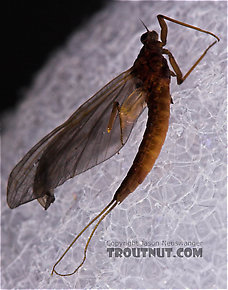 View 4 PicturesI really hoped to catch some good blue quill specimens on this trip, but they are very fragile mayflies and this one was in the best condition of the few that I caught after I drove them home to my camera. It may not be pretty, but you get an idea of the size/shape/color anyway.
View 4 PicturesI really hoped to catch some good blue quill specimens on this trip, but they are very fragile mayflies and this one was in the best condition of the few that I caught after I drove them home to my camera. It may not be pretty, but you get an idea of the size/shape/color anyway.
 View 4 PicturesI really hoped to catch some good blue quill specimens on this trip, but they are very fragile mayflies and this one was in the best condition of the few that I caught after I drove them home to my camera. It may not be pretty, but you get an idea of the size/shape/color anyway.
View 4 PicturesI really hoped to catch some good blue quill specimens on this trip, but they are very fragile mayflies and this one was in the best condition of the few that I caught after I drove them home to my camera. It may not be pretty, but you get an idea of the size/shape/color anyway.Male Paraleptophlebia (Blue Quills and Mahogany Duns) Mayfly Spinner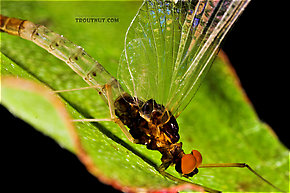 View 15 PicturesI wasn't actually fishing the river where I caught this one. I was just scouting, didn't like the look of the water, and as I was walking back to the car this little dun landed on my vest. Why can't they all be so easy to collect?
View 15 PicturesI wasn't actually fishing the river where I caught this one. I was just scouting, didn't like the look of the water, and as I was walking back to the car this little dun landed on my vest. Why can't they all be so easy to collect?
 View 15 PicturesI wasn't actually fishing the river where I caught this one. I was just scouting, didn't like the look of the water, and as I was walking back to the car this little dun landed on my vest. Why can't they all be so easy to collect?
View 15 PicturesI wasn't actually fishing the river where I caught this one. I was just scouting, didn't like the look of the water, and as I was walking back to the car this little dun landed on my vest. Why can't they all be so easy to collect?Female Paraleptophlebia (Blue Quills and Mahogany Duns) Mayfly Adult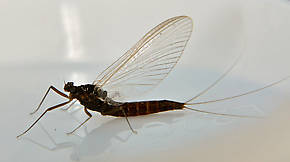 View 1 PicturesThis female exhibits the dark chocolate color so common in this genus.
View 1 PicturesThis female exhibits the dark chocolate color so common in this genus.
 View 1 PicturesThis female exhibits the dark chocolate color so common in this genus.
View 1 PicturesThis female exhibits the dark chocolate color so common in this genus.See 26 more specimens...
Top 10 Fly Hatches
Top Gift Shop Designs
Eat mayflies.
Top Insect Specimens
Miscellaneous Sites
Troutnut.com is copyright © 2004-2024 Jason
Neuswanger (email Jason). See my FAQ for information about use of my images.
 privacy policy
privacy policy

